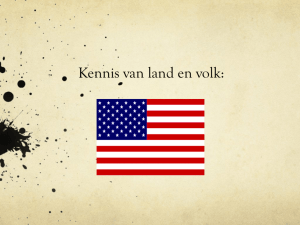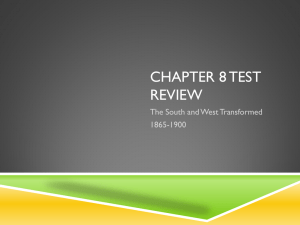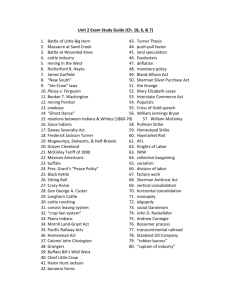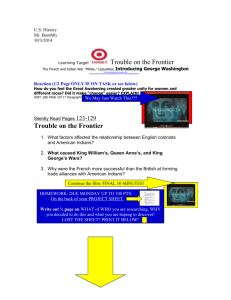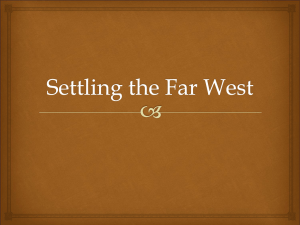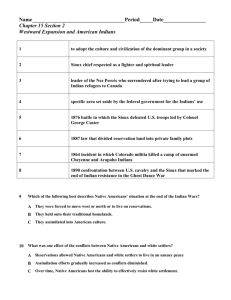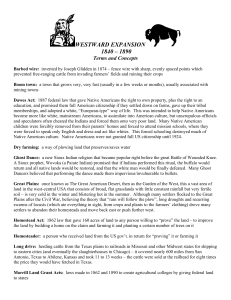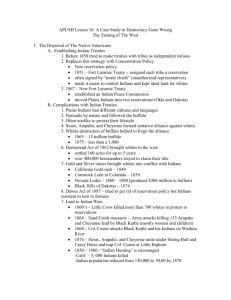APUSH Talking Points
advertisement
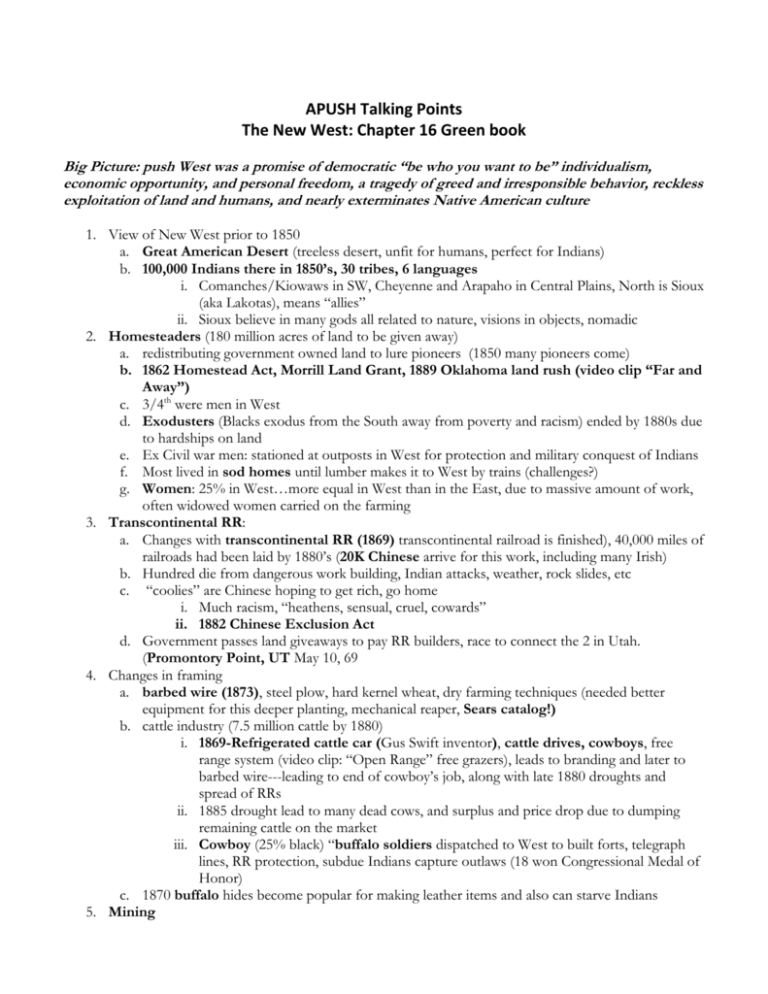
APUSH Talking Points The New West: Chapter 16 Green book Big Picture: push West was a promise of democratic “be who you want to be” individualism, economic opportunity, and personal freedom, a tragedy of greed and irresponsible behavior, reckless exploitation of land and humans, and nearly exterminates Native American culture 1. View of New West prior to 1850 a. Great American Desert (treeless desert, unfit for humans, perfect for Indians) b. 100,000 Indians there in 1850’s, 30 tribes, 6 languages i. Comanches/Kiowaws in SW, Cheyenne and Arapaho in Central Plains, North is Sioux (aka Lakotas), means “allies” ii. Sioux believe in many gods all related to nature, visions in objects, nomadic 2. Homesteaders (180 million acres of land to be given away) a. redistributing government owned land to lure pioneers (1850 many pioneers come) b. 1862 Homestead Act, Morrill Land Grant, 1889 Oklahoma land rush (video clip “Far and Away”) c. 3/4th were men in West d. Exodusters (Blacks exodus from the South away from poverty and racism) ended by 1880s due to hardships on land e. Ex Civil war men: stationed at outposts in West for protection and military conquest of Indians f. Most lived in sod homes until lumber makes it to West by trains (challenges?) g. Women: 25% in West…more equal in West than in the East, due to massive amount of work, often widowed women carried on the farming 3. Transcontinental RR: a. Changes with transcontinental RR (1869) transcontinental railroad is finished), 40,000 miles of railroads had been laid by 1880’s (20K Chinese arrive for this work, including many Irish) b. Hundred die from dangerous work building, Indian attacks, weather, rock slides, etc c. “coolies” are Chinese hoping to get rich, go home i. Much racism, “heathens, sensual, cruel, cowards” ii. 1882 Chinese Exclusion Act d. Government passes land giveaways to pay RR builders, race to connect the 2 in Utah. (Promontory Point, UT May 10, 69 4. Changes in framing a. barbed wire (1873), steel plow, hard kernel wheat, dry farming techniques (needed better equipment for this deeper planting, mechanical reaper, Sears catalog!) b. cattle industry (7.5 million cattle by 1880) i. 1869-Refrigerated cattle car (Gus Swift inventor), cattle drives, cowboys, free range system (video clip: “Open Range” free grazers), leads to branding and later to barbed wire---leading to end of cowboy’s job, along with late 1880 droughts and spread of RRs ii. 1885 drought lead to many dead cows, and surplus and price drop due to dumping remaining cattle on the market iii. Cowboy (25% black) “buffalo soldiers dispatched to West to built forts, telegraph lines, RR protection, subdue Indians capture outlaws (18 won Congressional Medal of Honor) c. 1870 buffalo hides become popular for making leather items and also can starve Indians 5. Mining a. 49’ers in California 57000 by 1860 b. Then gold discovered in Nevada, Montana, Dakotas, Black Hills, Rocky Mountain Regions (1859) Comstock Lode of silver, Sutter’s Mill in Oregon, by 1889, in Montana, Dakotas and Washington state) c. Wild Wild West i. Town spring up overnight anywhere near gold/silver discoveries ii. Lawlessness, gambling, prostitution, vigilante rule, finally leads to stable communities d. Mining and The Environment i. Tons of dirt and debris destroy land after hydraulic mining and dredging, farmers pissed, finally laws will control this around 1884 (Woodruff v N Bloomfield Gravel Mining Company) 6. Indian Wars: (goes with Prezi) a. 1851 Fort Laramie Treaty: define tribal borders, allows whites to pass through lands safely, all army to build roads/forts b. 1864: Sand Creek Massacre: John Chivington’s “foulest and most unjustifiable crime in the annals of America, 200 killed c. 1867: Sioux agree to go to Black Hills, govt peace commission is created to move Indians by treaty to reservations d. Red Cloud in 1870 “we are melting like snow and the white man is growing like spring grass” e. 1874: Custer’s Last Stand at Little Big Horn (success for Indians) f. Office of Indian Affairs created to “walk the white man’s road” g. Reservations: starvation, disease, alcoholism i. 1750: 30 million buffalo, by 1900 only a few hundred left ii. Average white killed 100 day, for food and to starve Indians “every buffalo dead is an Indian gone” iii. Drought also killed off (late 1880s) h. 1879: Nez Perce “I am tired of fighting, Our chiefs are killed, the old men are all dead…I will fight no more forever.”-Chief Joseph i. 1888: Ghost Dance craze starts in Indians (thought it would restore land), by 1890 Sioux were doing this so much it alarmed military i. Dec 29 1890 Wounded Knee, 25 soldiers die, 200 Indians who tried to surrender 7. Indian Policy a. 1881 Helen Hunt Jackson A Century of Dishonor (impact like Uncle Tom’s Cabin) b. Assimilation: Dawes Severalty Act of 1887 8. 1890 “End of the Frontier”: Fredrick Jackson Turner a. 1890 census reports frontier era is over, all land is “settled” b. Argues frontier shapes American character...”restless nervous energy…frontier is closes and with it, the first period in American history c. Influences historians…will we keep pushing west…attitude of West “get in, get rich, get out”
